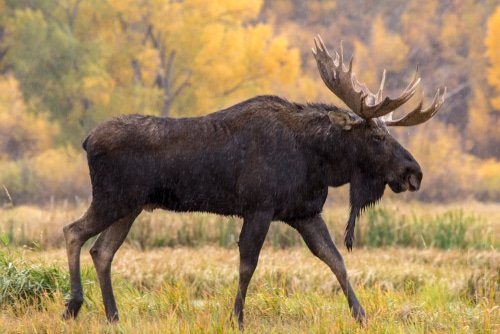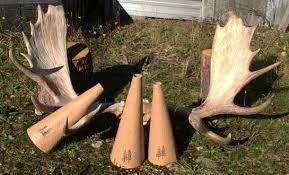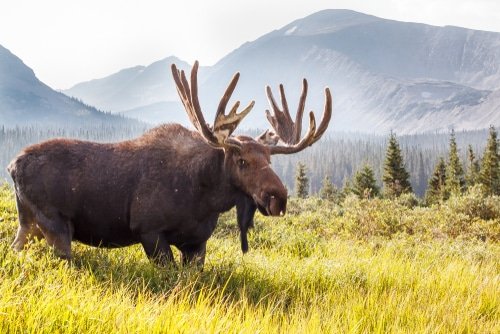Moose communication plays a crucial role in the intricate social structure of moose. These majestic creatures rely on effective communication to navigate their environment, establish dominance, find mates, and ensure the overall well-being of their herd.
From warning others of potential danger to conveying reproductive readiness during mating season, moose communication is vital for survival. Moose encounter challenges that require effective communication in the vast forests and open meadows where they dwell.
By exchanging information through different means, they can avoid predators together, maintain social bonds within their herd, and successfully reproduce. The ability to communicate allows them to coordinate movements as a group and respond collectively to external stimuli, ensuring their safety and prosperity.
Overview of the different ways moose communicate
Moose employs various communication methods, combining vocalizations, body language cues, visual displays, and scent marking. Their repertoire reflects the intricacies of their social interactions and helps them convey specific messages in various situations.
One prominent aspect of moose communication is vocalization. Moose can express distinct emotions or intentions through a range of low grunts and bellows or high-pitched whistles and squeals.
These vocalizations serve purposes such as warning others about potential threats or attracting potential mates during the rutting season. Additionally, moose rely on non-vocal forms of communication through body language.
They use specific ear positions, tail movements, head gestures, stomping feet, or swaying movements to convey messages within their herd. Scent marking is another notable form these magnificent animals use; they spray urine to establish territorial boundaries or rub antlers on trees for scent dissemination.
Combined with these forms of communication come visual displays unique to moose behavior. Dominance contests often involve the impressive display of antlers, where size and symmetry play a significant role.
Additionally, moose communicate through eye contact and staring, with different meanings behind prolonged stares and eye-widening serving as signs of aggression or submission. In the following sections, we will delve deeper into each method of communication employed by moose to gain a comprehensive understanding of how they interact and coexist in their natural habitat.
Description of Moose Vocalizations
Communication is a vital aspect of moose society, and they have developed an impressive repertoire of vocalizations to convey their messages. When it comes to moose vocalizations, they make a wide range of sounds. Their pitch and intensity can distinguish that. One common vocalization is the low grunt, which sounds like a deep rumble emanating from the chest of these majestic creatures.
These grunts can vary in length and intensity depending on the situation, and they are often used as a form of general communication among members of a moose group. In addition to grunts, moose are also known for their distinctive bellows.
These bellows are deep, resonating calls that can carry over long distances. Picture a bull moose standing tall with its head thrown back as it bellows into the wilderness—a truly awe-inspiring sight!
Bellows are often associated with dominance displays during mating season when males compete for the attention of females. The frequency and duration of bellows can indicate the size and strength of a male moose, serving as an advertisement for potential mates.
Meaning behind Different Vocalizations
Moose vocalizations serve various purposes in their daily lives. One important function is warning calls that help alert other group members about potential threats or dangers lurking in the vicinity. These warning signals are crucial when predators such as wolves or bears approach, allowing fellow moose to take evasive action and ensure their safety.
Another significant aspect of moose vocalizations revolves around mating calls. During the breeding season, bulls emit distinctive calls to attract potential mates—primarily cows who respond favorably to these alluring serenades.
The mating calls typically involve high-pitched whistles or squeals that reverberate through forests and meadows, signaling readiness for reproduction. By utilizing different vocal cues such as grunts, bellows, whistles, and squeals, moose effectively communicate their intentions and emotions within their social circles.
These vocalizations facilitate essential interactions between individuals and play a crucial role in maintaining the harmony and cohesion of moose communities. So, next time you hear the sound of a moose vocalizing in the wild, take a moment to appreciate the complexity and significance behind those enchanting calls.
Non-Vocal Communication in Moose
Body language and postures used by moose
When it comes to communication, moose rely not only on their vocalizations but also on their body language. They have a range of subtle yet distinct movements that convey various messages to other moose.
One important aspect of moose body language is the position of their ears, tail, and head. For instance, an alert and attentive moose will hold its ears erect and forward-facing, indicating a state of heightened awareness.
Conversely, when a moose is relaxed or unthreatened, its ears may be positioned horizontally or droop slightly. In addition to their ears, the positioning of a moose’s tail can also reveal important information.
When a moose feels threatened or agitated, it may raise its tail as a sign of aggression. On the other hand, if a moose tucks its tail between its legs or holds it low against its rump, it often indicates submission or fear.
Stomping feet or swaying movements
Moose have developed unique ways to communicate through physical movements as well. One example is when they stomp their feet on the ground. This behavior can serve multiple purposes; sometimes, it’s an attempt to alert others nearby about potential danger in the vicinity.
The vibrations created by stomping carry through the ground and act as an alarm signal for other moose. Furthermore, swaying movements are another form of non-vocal communication observed among these majestic creatures.
When threatened or annoyed by insects during warmer months, a moose may sway from side to side rhythmically as if engaged in an elegant dance routine. It intimidates predators and deters bothersome flies from landing on sensitive areas like their faces and eyes.
Scent marking as a form of communication
Besides their physical gestures, moose also use scent markings to communicate important messages to others. Urine spraying is a common method employed by both male and female moose.
This act marks their territory and provides valuable information about the individual who left the scent. The distinct odor left behind is a clear indication to other moose regarding the presence and dominance of the one who marked that area.
Another interesting behavior related to scent marking in moose is rubbing antlers on trees. The males, known as bulls, will vigorously rub their antlers against tree trunks, stripping off bark and leaving behind their unique scent.
This action disseminates their aroma throughout the surrounding area, further establishing their presence and dominance. It helps potential rivals understand whom they’re dealing with without engaging in confrontations.
Non-vocal communication is integral in moose society, conveying essential information about territory boundaries, social status, and emotional states without a single sound. Through body language, stomping feet or swaying movements, and scent-marking behaviors like urine spraying and tree-rubbing with antlers for scent dissemination, these magnificent creatures are adept at expressing themselves non-verbally.

Visual Communication in Moose
Antler Displays during Dominance Contests
In the majestic world of moose, antlers play a crucial role in communicating dominance and establishing hierarchy within their social structure. A spectacular display of antler prowess unfolds when two bull moose come face to face, ready to determine who will be the alpha.
These magnificent creatures use their antlers, which can span up to six feet wide, to signal their strength and assert dominance over their rivals. The size and symmetry of the antlers are essential indicators of a moose’s fitness and genetic superiority; thus, they serve as visual cues during these contests.
Rattling Antlers to Intimidate Rivals
When it comes to asserting dominance over rivals, moose don’t rely solely on the grandeur of their antlers. They take it one step further by engaging in an intimidating behavior known as rattling.
This involves forcefully clashing their mighty antlers with tremendous force, producing a series of thunderous echoes reverberating through the forest. The purpose behind this impressive display is twofold: first, it serves as an auditory warning signifying strength and aggression; secondly, it intimidates rivals by showcasing physical prowess while simultaneously creating an imposing spectacle.
Eye Contact and Staring as a Form of Communication
While vocalizations and body language play significant roles in moose communication, eye contact holds its unique power among these magnificent beasts. Eye contact between two individuals can convey various messages depending on the context.
Sometimes, prolonged stares indicate aggression or territorial defense—a warning shot before a physical confrontation. On the other hand, eye contact can also signify submission or acknowledgment of another moose’s authority within the social hierarchy.
Different Meanings Behind Prolonged Stares
The duration of a moose’s stare is another factor that conveys different meanings. A prolonged, direct gaze can signify challenging dominance or asserting oneself as a rival in a potential conflict.
However, when one moose breaks eye contact and diverts its gaze downward or sideways, it is often an act of submission or deference to the dominant individual. This nuanced visual communication adds depth to moose interactions and helps maintain social order within their communities.
Eye-Widening as a Sign of Aggression or Submission
In addition to eye contact and staring, moose employ another fascinating ocular behavior—eye-widening—to communicate specific intentions. When faced with an adversary or during territorial disputes, wide-eyed expressions indicate aggression and readiness for confrontation.
Conversely, when interacting with higher-ranking individuals, a moose may widen its eyes as a submissive gesture, showcasing respect and deference to their authority. Visual signals play an integral role in the intricate world of moose communication.
From antler displays during dominance contests to the subtle nuances conveyed through eye contact and staring, these remarkable creatures have mastered the art of non-verbal expression. Through their grand antlers and captivating gazes, moose communicate messages that resonate within their community while ensuring harmony amidst the wild beauty they call home.
Specialized Forms of Moose Communication
Moose produce these low-frequency sounds by vocalizing through structures called laryngeal sacs in their throat. As they emit these subsonic rumbles, the vibrations travel through their bodies and into the surrounding air. These vibrations create invisible sound waves trailing the landscape.
Interestingly, unlike audible vocalizations, which can be affected by various factors like wind or vegetation density, infrasound remains remarkably consistent and unaffected by such environmental conditions. Its ability to penetrate undeterred through different terrains enables moose to communicate effectively across vast expanses, ensuring their messages reach distant members of their social groups.
The role of infrasound in maintaining social bonds
Infrasound fosters social cohesion among moose populations. It is an efficient means for individuals to maintain contact with one another over long distances without needing direct visual or auditory interactions.
This subsonic language helps establish and strengthen social bonds within moose communities. Mature males, or bulls, employ infrasound during the breeding season to attract mates and announce their presence to potential rivals.
Bulls communicate their availability and dominance by emitting deep resonating rumbles that can carry for several kilometers. This low-frequency communication also helps prevent physical confrontations between males by allowing them to assess each other’s size and strength from a distance.
In addition to mating calls, moose use infrasound for more subtle social interactions. For instance, mothers may employ infrasonic vocalizations to locate and communicate with their calves over distances when separated in dense vegetation.
The unique ability of moose to communicate through infrasound highlights the depth of their social connections and the complexity of their communication system. Overall, understanding the significance of infrasound in moose communication gives us a glimpse into this hidden world of acoustic messaging that plays a crucial role in maintaining social bonds among these majestic creatures.
Moose Communication with Calves
Mother-calf bonding through vocalizations
The bond between a mother moose, or cow, and her calf is remarkable regarding moose communication. The cow uses vocalizations to establish and reinforce this special connection with her offspring.
One of the most heartwarming aspects of moose communication is the soft grunts emitted by the cow to reassure her calf. These gentle grunts serve as a constant source of comfort for the young one, conveying a sense of protection and security.
It’s like a secret language that only they understand. The mother expresses her love and care through these tender vocalizations, creating a strong foundation for their relationship.
Cow’s soft grunts to reassure the calf
The cow’s soft grunts hold immense significance in moose communication. These soothing sounds are used as reassurance and serve as cues for survival skills.
As they navigate their environment, calves associate specific situations with their mother’s grunts. For example, if danger approaches or something unfamiliar is nearby, the cow will emit distinct grunting patterns to alert her calf about potential threats.
This helps them understand what is safe and requires caution in their surroundings. Through these vocal exchanges, moose mothers guide their calves into adulthood while instilling confidence and knowledge.
Conclusion
Exploring the intricacies of moose communication reveals an awe-inspiring world filled with complexity and tenderness. From the range of vocalizations that express everything from warning signs to mating cues to non-vocal forms such as body language and scent marking – every aspect plays a vital role in maintaining social bonds among these majestic creatures. Understanding moose communication allows us to glimpse their society and provides valuable insights into how they navigate their environment.
It is a reminder of the beauty and complexity of nature and the deep connections between animals. So, let us appreciate these fascinating creatures and their remarkable communication skills and continue to marvel at the wonders of the animal kingdom.







Thank you for your sharing. I am worried that I lack creative ideas. It is your article that makes me full of hope. Thank you. But, I have a question, can you help me?
Good write-up. I definitely love this website. Keep writing!
There is noticeably big money to understand about this. I suppose you’ve made specific nice points in features also.
fantastic points altogether, you just gained emblem reader. What could you suggest in regards to your post that you simply made some days ago? Any positive?
Thanks for your recommendations on this blog. One thing I want to say is that purchasing electronic products items over the Internet is not something new. The fact is, in the past several years alone, the marketplace for online electronic devices has grown noticeably. Today, you’ll find practically any kind of electronic device and tools on the Internet, ranging from cameras and also camcorders to computer elements and video games consoles.
I needed to thank you for this wonderful read!! I certainly loved every bit of it. I’ve got you saved as a favorite to look at new things you post…
The the next time I just read a weblog, I really hope that it doesnt disappoint me as much as this one. Get real, It was my method to read, but When i thought youd have something interesting to express. All I hear is usually a number of whining about something you could fix when you werent too busy looking for attention.
I went over this site and I think you have a lot of great information, bookmarked (:.
Great write-up, I¡¦m normal visitor of one¡¦s website, maintain up the nice operate, and It is going to be a regular visitor for a lengthy time. prishtina travel
Good aftie” i am a blogger too, and i can see that you are a nice blogger too,
corporate events are filled with lots of exciting things and some promotional items too.
Oh my goodness! Awesome article dude! Many thanks, However I am having difficulties with your RSS. I don’t understand the reason why I can’t subscribe to it. Is there anybody having identical RSS problems? Anybody who knows the answer can you kindly respond? Thanks!!
It is truly a nice and helpful piece of information. I?m happy that you shared this helpful information with us. Please keep us informed like this. Thanks for sharing.
The camera work heightens this loss of individuality by filming everyone from the back or side whenever there is action, so close you can’t tell who is doing what, or were in relation to other people they are doing anything with.
I was reading some of your content on this website and I conceive this internet site is really informative ! Keep on putting up.
It is in reality a great and useful piece of information. I am glad that you just shared this helpful information with us. Please keep us informed like this. Thanks for sharing.
you are really a good webmaster. The website loading speed is incredible. It seems that you’re doing any unique trick. Moreover, The contents are masterpiece. you’ve done a great job on this topic!
Last month, when i visited your blog i got an error on the mysql server of yours.*’.*-
That is the best blog for anybody who wants to search out out about this topic. You realize so much its virtually onerous to argue with you (not that I actually would want…HaHa). You undoubtedly put a brand new spin on a topic thats been written about for years. Great stuff, just nice!
Everyone loves it when individuals get together and share ideas. Great site, continue the good work!
You ought to experience a tournament for example of the greatest blogs on the internet. I’ll recommend this website!
I found your blog site on google and verify a few of your early posts. Continue to maintain up the very good operate. I simply further up your RSS feed to my MSN News Reader. Seeking ahead to reading extra from you later on!…
great work… Excellent weblog here! Also your web site a lot up fast! What web host are you the usage of? Can I get your associate link on your host? I want my website loaded up as fast as yours lol…
TY for the great info! I would never have gotten this myself!
I truly appreciate this post. I have been looking everywhere for this! Thank goodness I found it on Google. You have made my day! Thx again..
It is best to take part in a contest for the most effective blogs on the web. I’ll recommend this web site!
I dont usually post on many Blogs, still I simply needs to express gratitude continue the spectacular work. Ok unfortunately it’s once again time to get at school.
Thought provoking, and that i will need to ponder it some more.. saved. Hope to see an update quickly!
is there something like a free translation service that we can use online ? `
I like the helpful info you provide in your articles. I’ll bookmark your blog and check again here frequently. I am quite sure I’ll learn a lot of new stuff right here! Best of luck for the next!
i support herbal products because they are all natural and from what i know, they do not carry nasty side effects..
i am very picky about baby toys, so i always choose the best ones`
This is really interesting, You’re a very skilled blogger. I have joined your rss feed and look forward to seeking more of your magnificent post. Also, I’ve shared your site in my social networks!
This unique comment appears to get quite a few web page visitors. How should you market it? It also provides beneficial completely unique turn in tips. Man making a process huge perhaps comprehensive to specifics of is the central process.
Thanks, I enjoyed – Gulvafslibning | Kurt Gulvmand. It was good. View my blog sometime, it all about Altamonte Springs, FL Real Estate.
You really make it appear really easy together with your presentation but I to find this matter to be really one thing which I believe I would by no means understand. It sort of feels too complicated and very huge for me. I am having a look ahead on your next publish, I’ll attempt to get the dangle of it!
After study several of the blogs on your internet site now, and that i truly such as your way of blogging. I bookmarked it to my bookmark web site list and are checking back soon. Pls have a look at my internet site as well and told me what you consider.
I wanted to thank you for this good read!! I definitely loved every bit of it. I have you book marked to look at new stuff you post…
I am usually to blogging i really appreciate your posts. Your content has really peaks my interest. I’m going to bookmark your website and keep checking achievable information.
I wanted to check up and let you know how great I cherished discovering your website today. We would consider it a great honor to work at my business office and be able to utilize the tips provided on your blog and also be involved in visitors’ responses like this. Should a position associated with guest article writer become on offer at your end, you should let me know.
very good post, i definitely enjoy this site, carry on it
*I’m impressed, I must say. Really rarely do I encounter a blog that’s both educative and entertaining, and let me tell you, you have hit the nail on the head. Your idea is outstanding; the issue is something that not enough people are speaking intelligently about. I am very happy that I stumbled across this in my search for something relating to this.
I know this isn’t exactly on subject, but i’ve a site using the identical program as properly and i am getting troubles with my comments displaying. is there a setting i am missing? it’s potential it’s possible you’ll assist me out? thanx.
Youre so cool! I dont suppose Ive read something similar to this before. So nice to get somebody by incorporating authentic applying for grants this subject. realy appreciation for starting this up. this website are some things that’s needed over the internet, somebody after a little bit originality. helpful project for bringing something new to the web!
I your writing style really enjoying this site.
This is the appropriate weblog for wishes to be made aware of this topic. You already know a great deal its nearly not easy to argue along (not that I really would want…HaHa). You certainly put a different spin with a topic thats been revealed for years. Excellent stuff, just great!
There are incredibly plenty of details that way to take into consideration. It really is a excellent examine talk about. I provide thoughts above as general inspiration but clearly you’ll find questions like the one you start up the place that the most essential factor will likely be getting work done in honest excellent faith. I don?t determine if guidelines have emerged around stuff like that, but I am certain your job is clearly labeled as an affordable game. Both children notice the impact of simply a moment’s pleasure, for the rest of their lives.
Simply wanna input that you have a very nice site, I enjoy the design and style it really stands out.
I think you will find a issue with your web sites utilizing Opera browser.